UTS 49001: Judgment and Decision Making - Reading Abstracts Assignment
VerifiedAdded on 2020/03/04
|5
|1679
|41
Homework Assignment
AI Summary
This assignment presents abstracts of several readings related to judgment and decision-making in organizational contexts. The abstracts cover key concepts from various books, including 'Knowing what you want: measuring liable values,' 'Decision Making: Descriptive, Normative and Prescriptive Interaction,' and 'Theories of risk perception: who fear what any why?'. The first abstract focuses on how individuals make judgments based on values, opinions, and the importance of coherence, while the second abstract explores risk perception and its impact on decision-making, considering macro, meso, and micro-level factors. The third abstract discusses decision-making under uncertainty, and the fourth abstract examines ethical management and its role in balancing employee and stakeholder interests. Each abstract includes a section on how the concepts relate to work experience, providing practical examples and solutions for better judgment and decision-making in the workplace. The assignment also provides a list of references to the books used.
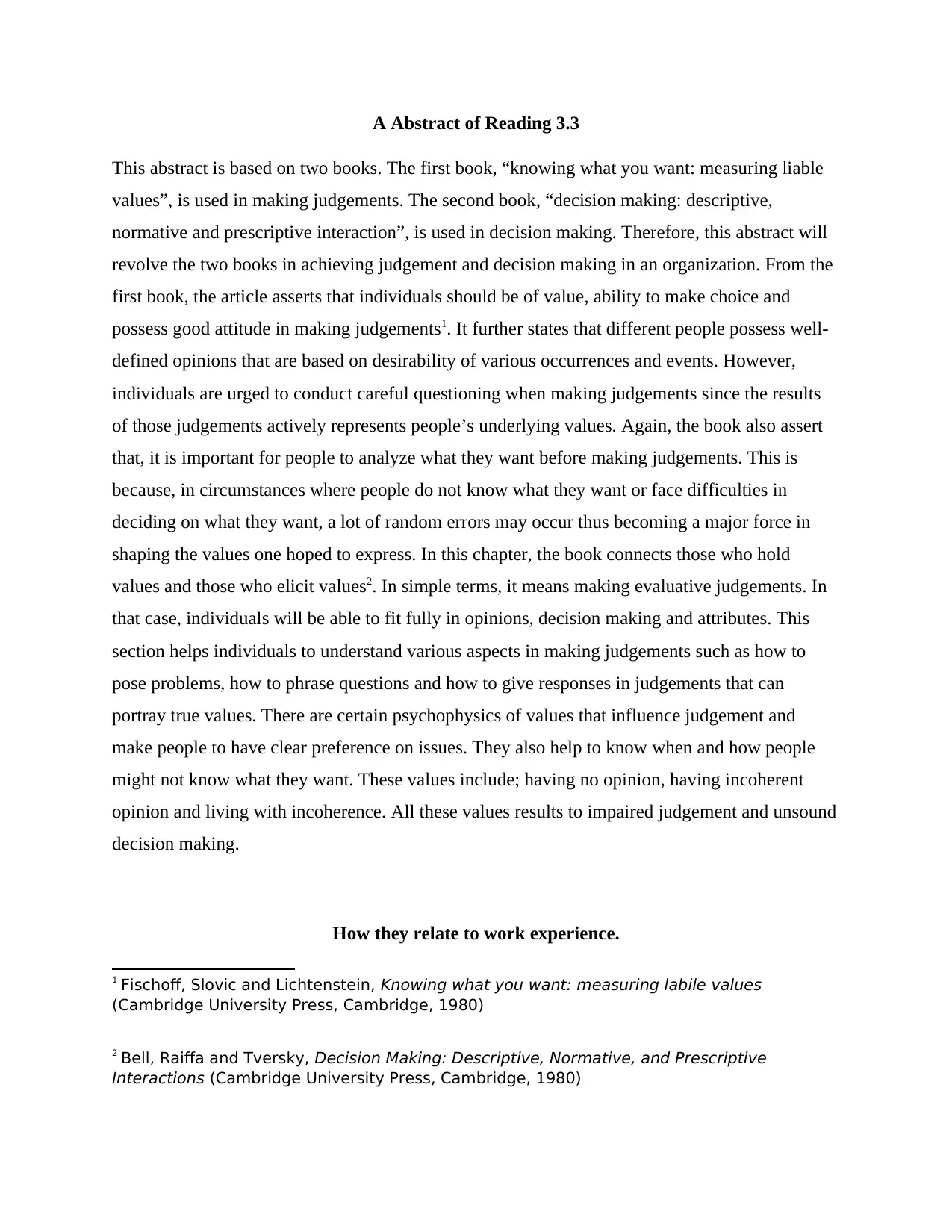
A Abstract of Reading 3.3
This abstract is based on two books. The first book, “knowing what you want: measuring liable
values”, is used in making judgements. The second book, “decision making: descriptive,
normative and prescriptive interaction”, is used in decision making. Therefore, this abstract will
revolve the two books in achieving judgement and decision making in an organization. From the
first book, the article asserts that individuals should be of value, ability to make choice and
possess good attitude in making judgements1. It further states that different people possess well-
defined opinions that are based on desirability of various occurrences and events. However,
individuals are urged to conduct careful questioning when making judgements since the results
of those judgements actively represents people’s underlying values. Again, the book also assert
that, it is important for people to analyze what they want before making judgements. This is
because, in circumstances where people do not know what they want or face difficulties in
deciding on what they want, a lot of random errors may occur thus becoming a major force in
shaping the values one hoped to express. In this chapter, the book connects those who hold
values and those who elicit values2. In simple terms, it means making evaluative judgements. In
that case, individuals will be able to fit fully in opinions, decision making and attributes. This
section helps individuals to understand various aspects in making judgements such as how to
pose problems, how to phrase questions and how to give responses in judgements that can
portray true values. There are certain psychophysics of values that influence judgement and
make people to have clear preference on issues. They also help to know when and how people
might not know what they want. These values include; having no opinion, having incoherent
opinion and living with incoherence. All these values results to impaired judgement and unsound
decision making.
How they relate to work experience.
1 Fischoff, Slovic and Lichtenstein, Knowing what you want: measuring labile values
(Cambridge University Press, Cambridge, 1980)
2 Bell, Raiffa and Tversky, Decision Making: Descriptive, Normative, and Prescriptive
Interactions (Cambridge University Press, Cambridge, 1980)
This abstract is based on two books. The first book, “knowing what you want: measuring liable
values”, is used in making judgements. The second book, “decision making: descriptive,
normative and prescriptive interaction”, is used in decision making. Therefore, this abstract will
revolve the two books in achieving judgement and decision making in an organization. From the
first book, the article asserts that individuals should be of value, ability to make choice and
possess good attitude in making judgements1. It further states that different people possess well-
defined opinions that are based on desirability of various occurrences and events. However,
individuals are urged to conduct careful questioning when making judgements since the results
of those judgements actively represents people’s underlying values. Again, the book also assert
that, it is important for people to analyze what they want before making judgements. This is
because, in circumstances where people do not know what they want or face difficulties in
deciding on what they want, a lot of random errors may occur thus becoming a major force in
shaping the values one hoped to express. In this chapter, the book connects those who hold
values and those who elicit values2. In simple terms, it means making evaluative judgements. In
that case, individuals will be able to fit fully in opinions, decision making and attributes. This
section helps individuals to understand various aspects in making judgements such as how to
pose problems, how to phrase questions and how to give responses in judgements that can
portray true values. There are certain psychophysics of values that influence judgement and
make people to have clear preference on issues. They also help to know when and how people
might not know what they want. These values include; having no opinion, having incoherent
opinion and living with incoherence. All these values results to impaired judgement and unsound
decision making.
How they relate to work experience.
1 Fischoff, Slovic and Lichtenstein, Knowing what you want: measuring labile values
(Cambridge University Press, Cambridge, 1980)
2 Bell, Raiffa and Tversky, Decision Making: Descriptive, Normative, and Prescriptive
Interactions (Cambridge University Press, Cambridge, 1980)
Paraphrase This Document
Need a fresh take? Get an instant paraphrase of this document with our AI Paraphraser
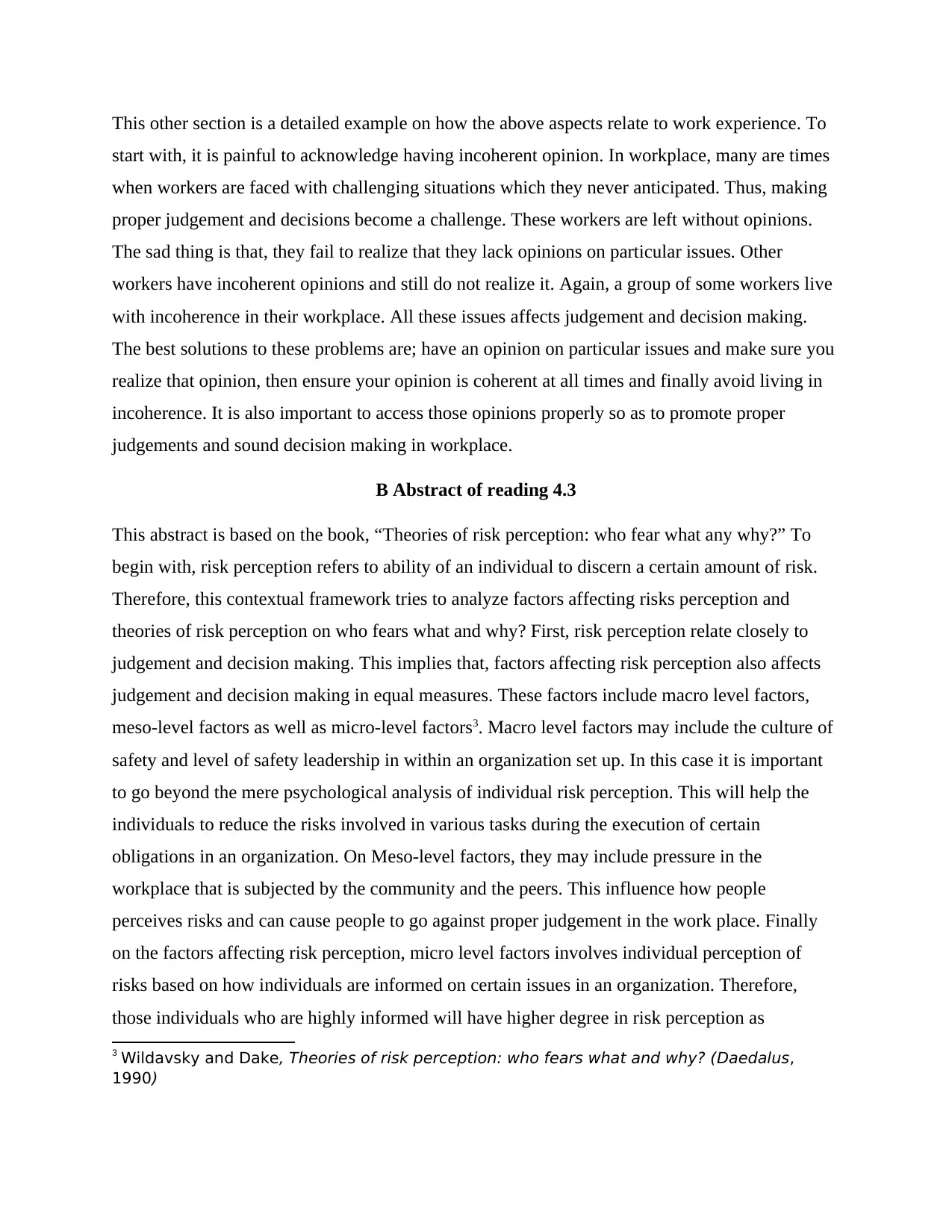
This other section is a detailed example on how the above aspects relate to work experience. To
start with, it is painful to acknowledge having incoherent opinion. In workplace, many are times
when workers are faced with challenging situations which they never anticipated. Thus, making
proper judgement and decisions become a challenge. These workers are left without opinions.
The sad thing is that, they fail to realize that they lack opinions on particular issues. Other
workers have incoherent opinions and still do not realize it. Again, a group of some workers live
with incoherence in their workplace. All these issues affects judgement and decision making.
The best solutions to these problems are; have an opinion on particular issues and make sure you
realize that opinion, then ensure your opinion is coherent at all times and finally avoid living in
incoherence. It is also important to access those opinions properly so as to promote proper
judgements and sound decision making in workplace.
B Abstract of reading 4.3
This abstract is based on the book, “Theories of risk perception: who fear what any why?” To
begin with, risk perception refers to ability of an individual to discern a certain amount of risk.
Therefore, this contextual framework tries to analyze factors affecting risks perception and
theories of risk perception on who fears what and why? First, risk perception relate closely to
judgement and decision making. This implies that, factors affecting risk perception also affects
judgement and decision making in equal measures. These factors include macro level factors,
meso-level factors as well as micro-level factors3. Macro level factors may include the culture of
safety and level of safety leadership in within an organization set up. In this case it is important
to go beyond the mere psychological analysis of individual risk perception. This will help the
individuals to reduce the risks involved in various tasks during the execution of certain
obligations in an organization. On Meso-level factors, they may include pressure in the
workplace that is subjected by the community and the peers. This influence how people
perceives risks and can cause people to go against proper judgement in the work place. Finally
on the factors affecting risk perception, micro level factors involves individual perception of
risks based on how individuals are informed on certain issues in an organization. Therefore,
those individuals who are highly informed will have higher degree in risk perception as
3 Wildavsky and Dake, Theories of risk perception: who fears what and why? (Daedalus,
1990)
start with, it is painful to acknowledge having incoherent opinion. In workplace, many are times
when workers are faced with challenging situations which they never anticipated. Thus, making
proper judgement and decisions become a challenge. These workers are left without opinions.
The sad thing is that, they fail to realize that they lack opinions on particular issues. Other
workers have incoherent opinions and still do not realize it. Again, a group of some workers live
with incoherence in their workplace. All these issues affects judgement and decision making.
The best solutions to these problems are; have an opinion on particular issues and make sure you
realize that opinion, then ensure your opinion is coherent at all times and finally avoid living in
incoherence. It is also important to access those opinions properly so as to promote proper
judgements and sound decision making in workplace.
B Abstract of reading 4.3
This abstract is based on the book, “Theories of risk perception: who fear what any why?” To
begin with, risk perception refers to ability of an individual to discern a certain amount of risk.
Therefore, this contextual framework tries to analyze factors affecting risks perception and
theories of risk perception on who fears what and why? First, risk perception relate closely to
judgement and decision making. This implies that, factors affecting risk perception also affects
judgement and decision making in equal measures. These factors include macro level factors,
meso-level factors as well as micro-level factors3. Macro level factors may include the culture of
safety and level of safety leadership in within an organization set up. In this case it is important
to go beyond the mere psychological analysis of individual risk perception. This will help the
individuals to reduce the risks involved in various tasks during the execution of certain
obligations in an organization. On Meso-level factors, they may include pressure in the
workplace that is subjected by the community and the peers. This influence how people
perceives risks and can cause people to go against proper judgement in the work place. Finally
on the factors affecting risk perception, micro level factors involves individual perception of
risks based on how individuals are informed on certain issues in an organization. Therefore,
those individuals who are highly informed will have higher degree in risk perception as
3 Wildavsky and Dake, Theories of risk perception: who fears what and why? (Daedalus,
1990)
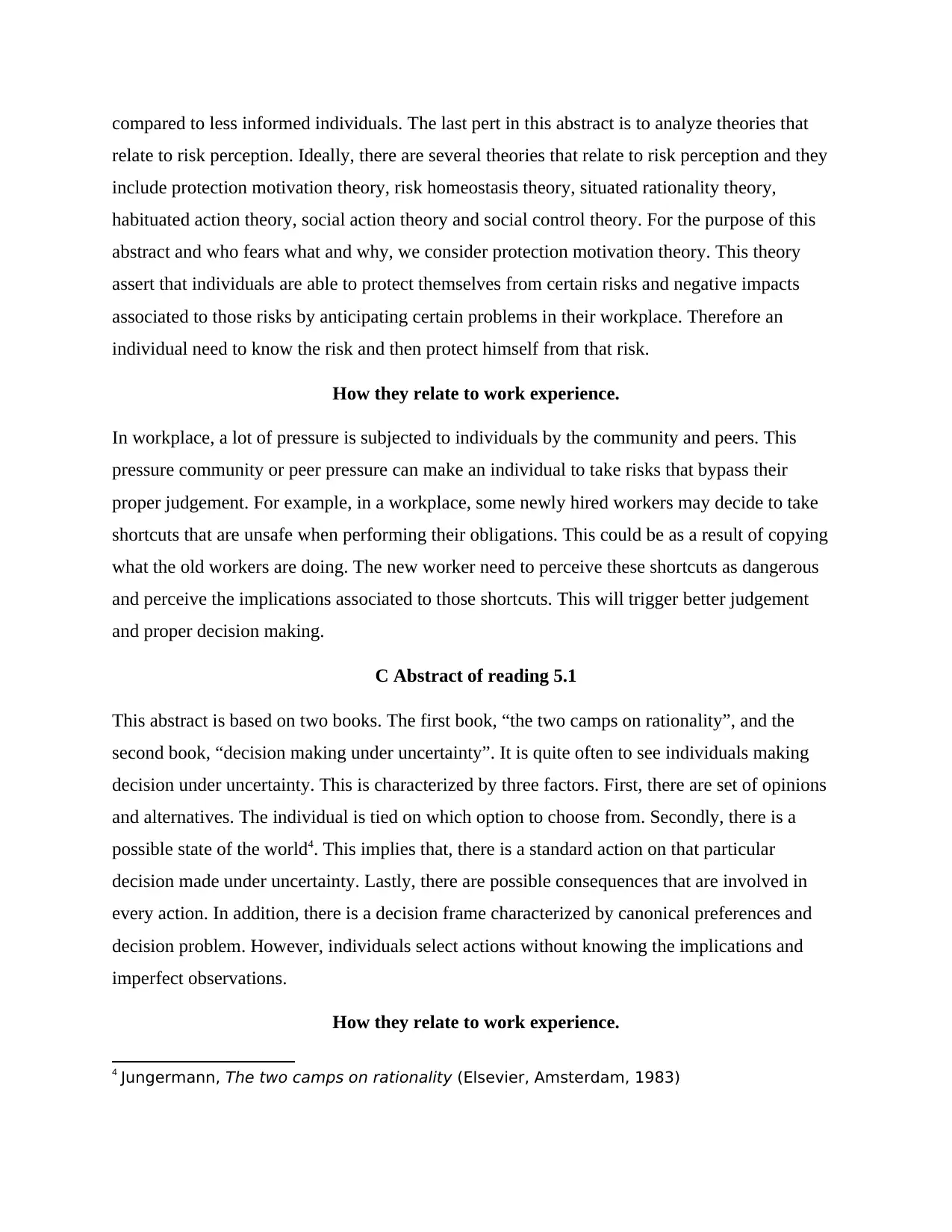
compared to less informed individuals. The last pert in this abstract is to analyze theories that
relate to risk perception. Ideally, there are several theories that relate to risk perception and they
include protection motivation theory, risk homeostasis theory, situated rationality theory,
habituated action theory, social action theory and social control theory. For the purpose of this
abstract and who fears what and why, we consider protection motivation theory. This theory
assert that individuals are able to protect themselves from certain risks and negative impacts
associated to those risks by anticipating certain problems in their workplace. Therefore an
individual need to know the risk and then protect himself from that risk.
How they relate to work experience.
In workplace, a lot of pressure is subjected to individuals by the community and peers. This
pressure community or peer pressure can make an individual to take risks that bypass their
proper judgement. For example, in a workplace, some newly hired workers may decide to take
shortcuts that are unsafe when performing their obligations. This could be as a result of copying
what the old workers are doing. The new worker need to perceive these shortcuts as dangerous
and perceive the implications associated to those shortcuts. This will trigger better judgement
and proper decision making.
C Abstract of reading 5.1
This abstract is based on two books. The first book, “the two camps on rationality”, and the
second book, “decision making under uncertainty”. It is quite often to see individuals making
decision under uncertainty. This is characterized by three factors. First, there are set of opinions
and alternatives. The individual is tied on which option to choose from. Secondly, there is a
possible state of the world4. This implies that, there is a standard action on that particular
decision made under uncertainty. Lastly, there are possible consequences that are involved in
every action. In addition, there is a decision frame characterized by canonical preferences and
decision problem. However, individuals select actions without knowing the implications and
imperfect observations.
How they relate to work experience.
4 Jungermann, The two camps on rationality (Elsevier, Amsterdam, 1983)
relate to risk perception. Ideally, there are several theories that relate to risk perception and they
include protection motivation theory, risk homeostasis theory, situated rationality theory,
habituated action theory, social action theory and social control theory. For the purpose of this
abstract and who fears what and why, we consider protection motivation theory. This theory
assert that individuals are able to protect themselves from certain risks and negative impacts
associated to those risks by anticipating certain problems in their workplace. Therefore an
individual need to know the risk and then protect himself from that risk.
How they relate to work experience.
In workplace, a lot of pressure is subjected to individuals by the community and peers. This
pressure community or peer pressure can make an individual to take risks that bypass their
proper judgement. For example, in a workplace, some newly hired workers may decide to take
shortcuts that are unsafe when performing their obligations. This could be as a result of copying
what the old workers are doing. The new worker need to perceive these shortcuts as dangerous
and perceive the implications associated to those shortcuts. This will trigger better judgement
and proper decision making.
C Abstract of reading 5.1
This abstract is based on two books. The first book, “the two camps on rationality”, and the
second book, “decision making under uncertainty”. It is quite often to see individuals making
decision under uncertainty. This is characterized by three factors. First, there are set of opinions
and alternatives. The individual is tied on which option to choose from. Secondly, there is a
possible state of the world4. This implies that, there is a standard action on that particular
decision made under uncertainty. Lastly, there are possible consequences that are involved in
every action. In addition, there is a decision frame characterized by canonical preferences and
decision problem. However, individuals select actions without knowing the implications and
imperfect observations.
How they relate to work experience.
4 Jungermann, The two camps on rationality (Elsevier, Amsterdam, 1983)
⊘ This is a preview!⊘
Do you want full access?
Subscribe today to unlock all pages.

Trusted by 1+ million students worldwide
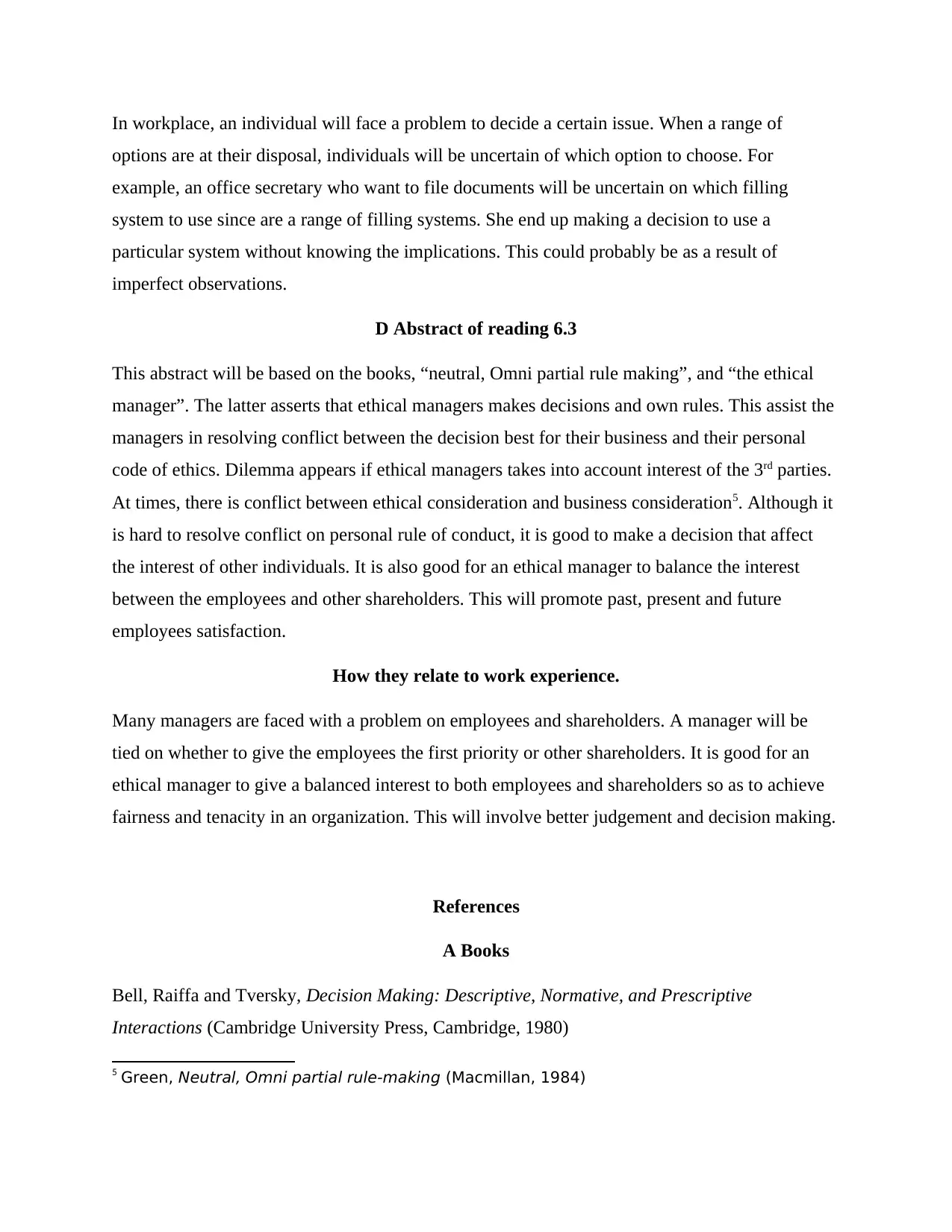
In workplace, an individual will face a problem to decide a certain issue. When a range of
options are at their disposal, individuals will be uncertain of which option to choose. For
example, an office secretary who want to file documents will be uncertain on which filling
system to use since are a range of filling systems. She end up making a decision to use a
particular system without knowing the implications. This could probably be as a result of
imperfect observations.
D Abstract of reading 6.3
This abstract will be based on the books, “neutral, Omni partial rule making”, and “the ethical
manager”. The latter asserts that ethical managers makes decisions and own rules. This assist the
managers in resolving conflict between the decision best for their business and their personal
code of ethics. Dilemma appears if ethical managers takes into account interest of the 3rd parties.
At times, there is conflict between ethical consideration and business consideration5. Although it
is hard to resolve conflict on personal rule of conduct, it is good to make a decision that affect
the interest of other individuals. It is also good for an ethical manager to balance the interest
between the employees and other shareholders. This will promote past, present and future
employees satisfaction.
How they relate to work experience.
Many managers are faced with a problem on employees and shareholders. A manager will be
tied on whether to give the employees the first priority or other shareholders. It is good for an
ethical manager to give a balanced interest to both employees and shareholders so as to achieve
fairness and tenacity in an organization. This will involve better judgement and decision making.
References
A Books
Bell, Raiffa and Tversky, Decision Making: Descriptive, Normative, and Prescriptive
Interactions (Cambridge University Press, Cambridge, 1980)
5 Green, Neutral, Omni partial rule-making (Macmillan, 1984)
options are at their disposal, individuals will be uncertain of which option to choose. For
example, an office secretary who want to file documents will be uncertain on which filling
system to use since are a range of filling systems. She end up making a decision to use a
particular system without knowing the implications. This could probably be as a result of
imperfect observations.
D Abstract of reading 6.3
This abstract will be based on the books, “neutral, Omni partial rule making”, and “the ethical
manager”. The latter asserts that ethical managers makes decisions and own rules. This assist the
managers in resolving conflict between the decision best for their business and their personal
code of ethics. Dilemma appears if ethical managers takes into account interest of the 3rd parties.
At times, there is conflict between ethical consideration and business consideration5. Although it
is hard to resolve conflict on personal rule of conduct, it is good to make a decision that affect
the interest of other individuals. It is also good for an ethical manager to balance the interest
between the employees and other shareholders. This will promote past, present and future
employees satisfaction.
How they relate to work experience.
Many managers are faced with a problem on employees and shareholders. A manager will be
tied on whether to give the employees the first priority or other shareholders. It is good for an
ethical manager to give a balanced interest to both employees and shareholders so as to achieve
fairness and tenacity in an organization. This will involve better judgement and decision making.
References
A Books
Bell, Raiffa and Tversky, Decision Making: Descriptive, Normative, and Prescriptive
Interactions (Cambridge University Press, Cambridge, 1980)
5 Green, Neutral, Omni partial rule-making (Macmillan, 1984)
Paraphrase This Document
Need a fresh take? Get an instant paraphrase of this document with our AI Paraphraser
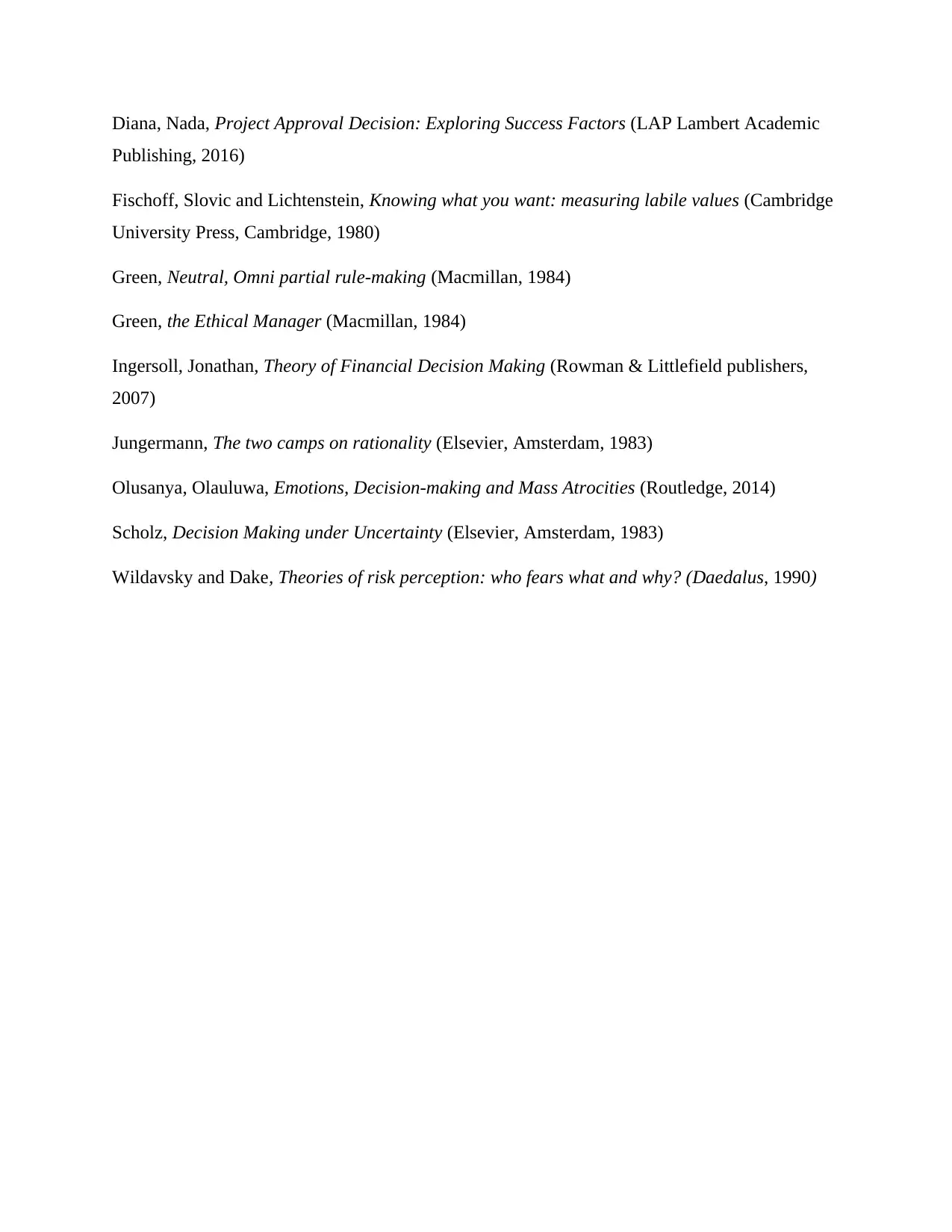
Diana, Nada, Project Approval Decision: Exploring Success Factors (LAP Lambert Academic
Publishing, 2016)
Fischoff, Slovic and Lichtenstein, Knowing what you want: measuring labile values (Cambridge
University Press, Cambridge, 1980)
Green, Neutral, Omni partial rule-making (Macmillan, 1984)
Green, the Ethical Manager (Macmillan, 1984)
Ingersoll, Jonathan, Theory of Financial Decision Making (Rowman & Littlefield publishers,
2007)
Jungermann, The two camps on rationality (Elsevier, Amsterdam, 1983)
Olusanya, Olauluwa, Emotions, Decision-making and Mass Atrocities (Routledge, 2014)
Scholz, Decision Making under Uncertainty (Elsevier, Amsterdam, 1983)
Wildavsky and Dake, Theories of risk perception: who fears what and why? (Daedalus, 1990)
Publishing, 2016)
Fischoff, Slovic and Lichtenstein, Knowing what you want: measuring labile values (Cambridge
University Press, Cambridge, 1980)
Green, Neutral, Omni partial rule-making (Macmillan, 1984)
Green, the Ethical Manager (Macmillan, 1984)
Ingersoll, Jonathan, Theory of Financial Decision Making (Rowman & Littlefield publishers,
2007)
Jungermann, The two camps on rationality (Elsevier, Amsterdam, 1983)
Olusanya, Olauluwa, Emotions, Decision-making and Mass Atrocities (Routledge, 2014)
Scholz, Decision Making under Uncertainty (Elsevier, Amsterdam, 1983)
Wildavsky and Dake, Theories of risk perception: who fears what and why? (Daedalus, 1990)
1 out of 5
Related Documents
Your All-in-One AI-Powered Toolkit for Academic Success.
+13062052269
info@desklib.com
Available 24*7 on WhatsApp / Email
![[object Object]](/_next/static/media/star-bottom.7253800d.svg)
Unlock your academic potential
Copyright © 2020–2025 A2Z Services. All Rights Reserved. Developed and managed by ZUCOL.




